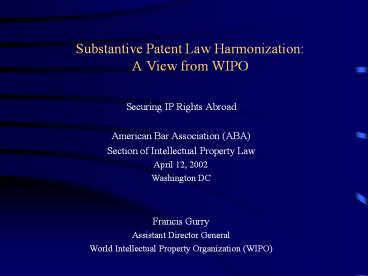Substantive Patent Law Harmonization: A View from WIPO - PowerPoint PPT Presentation
1 / 12
Title:
Substantive Patent Law Harmonization: A View from WIPO
Description:
Patentable subject matter and technical character (USA wants a broad approach) ... Establishing a Road Map. The limits of harmonization. confined to higher level law ... – PowerPoint PPT presentation
Number of Views:194
Avg rating:3.0/5.0
Title: Substantive Patent Law Harmonization: A View from WIPO
1
Substantive Patent Law HarmonizationA View from
WIPO
- Securing IP Rights Abroad
- American Bar Association (ABA)
- Section of Intellectual Property Law
- April 12, 2002
- Washington DC
- Francis Gurry
- Assistant Director General
- World Intellectual Property Organization (WIPO)
2
The Patent System WorldwideThe Current Context
- Rapidly increasing demand for patent rights
worldwide - the globalization of IP rights
- Stress in the system
- pendency periods
- Diversity of needs
- the dominance of the trilateral regions
- the emergence of growth in certain developing
countries - the place of small offices
3
Worldwide Demand for Patent Rights
Source Trilateral Statistical Reports
4
PCT Filings from Developing Countries
- 70.6 increase over 2000 in number of PCT
applications filed in developing
countries - Particularly high increase in
- China (188.4)
- India (102.6)
- Republic of Korea (53.1)
- Mexico (50.7)
- 5,378 international applications originated from
developing countries - Republic of Korea (2,318), China (1,670), South
Africa (418), India (316), Singapore (271)
5
Why Harmonize?
- Approximating legal to economic conditions
- Can patent policy be realized in globalizing
markets when it operate divergently in different
territories? - business method patents
- The mobility of knowledge as a factor of
production - the law of the export market rules
- Making choice of law less important
- Creating the Conditions for the Economically
Rational Use of Resources - The perspective of national IP Offices
- duplication of work
- The perspective of the user
- cost of obtaining and maintaining protection
6
Patent Law Harmonization
- Negotiations 1985 to 1991
- 1991 Diplomatic Conference failed to conclude a
treaty - Patent Law Treaty (PLT) 2000
- formal and procedural matters
- entry into force accession or ratification by 10
States (1 so far) - Draft Substantive Patent Law Treaty (SPLT) now
being discussed by Standing Committee on Patents
(SCP) - 2 SCP meetings in 2001 2 in 2002
- Diplomatic Conference in 2004 (?)
7
Substantive Patent Law Harmonization(SPLT)
- Issues being addressed
- definition of prior art novelty, inventive
step/non-obviousness and industrial
applicability/utility sufficient disclosure
drafting and interpretation of claims - includes disclosures on the Internet
- Other issues on the table
- first-to-file, early publication, post-grant
opposition - Interface between PCT and PLT
- Provisions at three levels treaty, regulations,
practice guidelines (harmonizing Office practices)
8
SPLTSome controversial issues
- Patentable subject matter and technical character
(USA wants a broad approach) - Inclusion of industrial applicability/utility
- Support requirement (Europe) -v- written
description requirement (USA) - Grace period
- Grounds for refusal/invalidation of an
application - unlawfully acquired genetic resources as a ground?
9
Establishing a Road Map
- The limits of harmonization
- confined to higher level law
- tension with other areas of public policy and
accommodating development - the slowness of multilateral processes
- limited impact on cost efficiencies
- Need for additional, complementary strategies
- WIPO Patent Agenda
10
Possible Elements of Additional Strategies
- Development of PCT
- PCT Reform
- Harmonization of practices
- experiments in mutual exploitation of work
product - use of PCT as a vehicle
- Encouragement of regional systems
- intermediate solution
- Thinking the long-term need for, and architecture
of, a global title
11
Obstacles
- Managing the increasing number of tensions
between intellectual property and other areas of
public policy - health, biodiversity, standardization,
information is free, development - are uniform law and practice possible?
- Managing the tensions of re-structuring in
administrations and professions - the changing role of the national office
- fear on the part of intellectual property
professionals
12
URLs
- http//www.wipo.int (general)
- http//www.wipo.int/eng/document/scp_ce/index_6.ht
m - (SPLT)
- http//www.wipo.int/pct/en/index.html (PCT)
- http//patentagenda.wipo.int (WIPO Patent Agenda)

